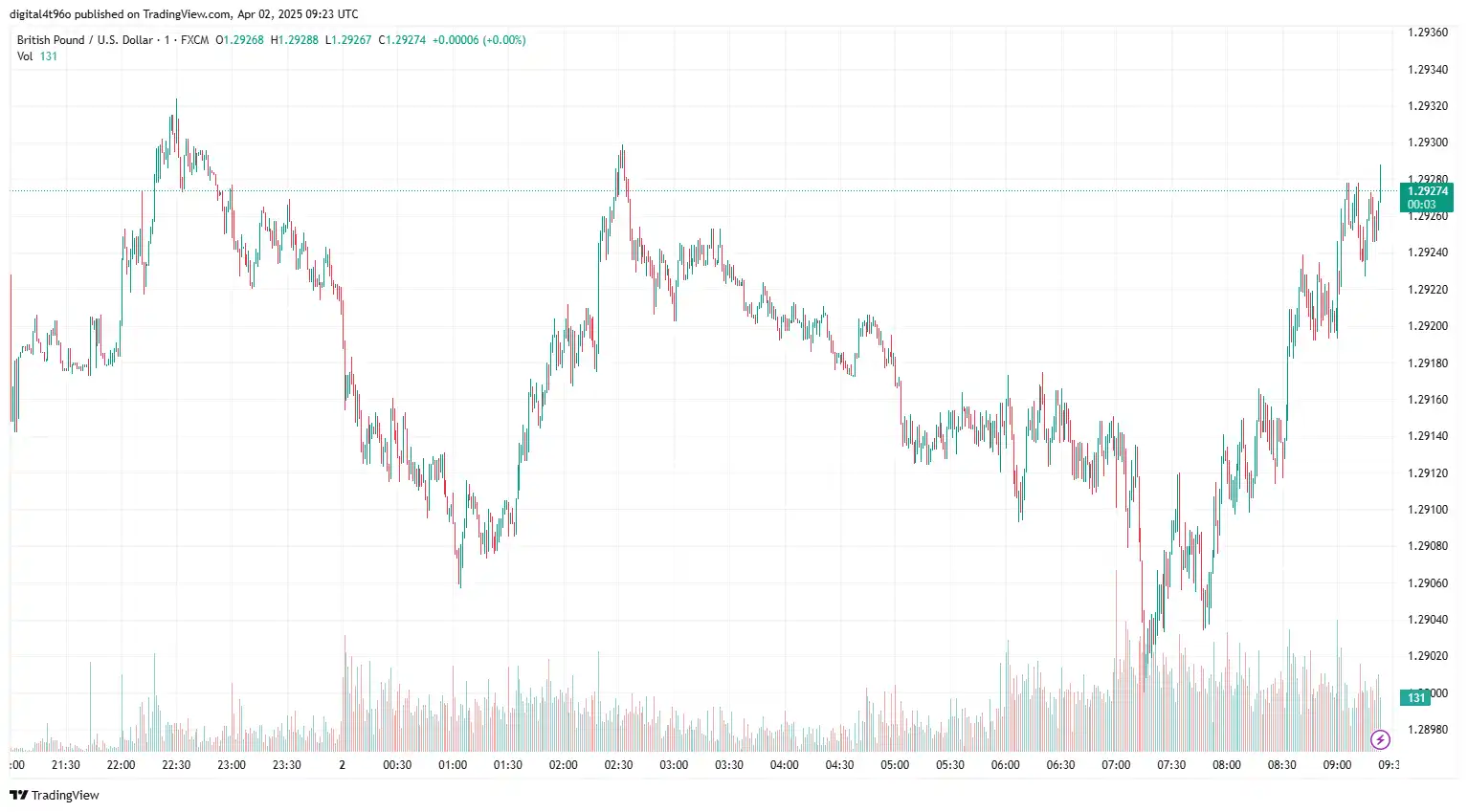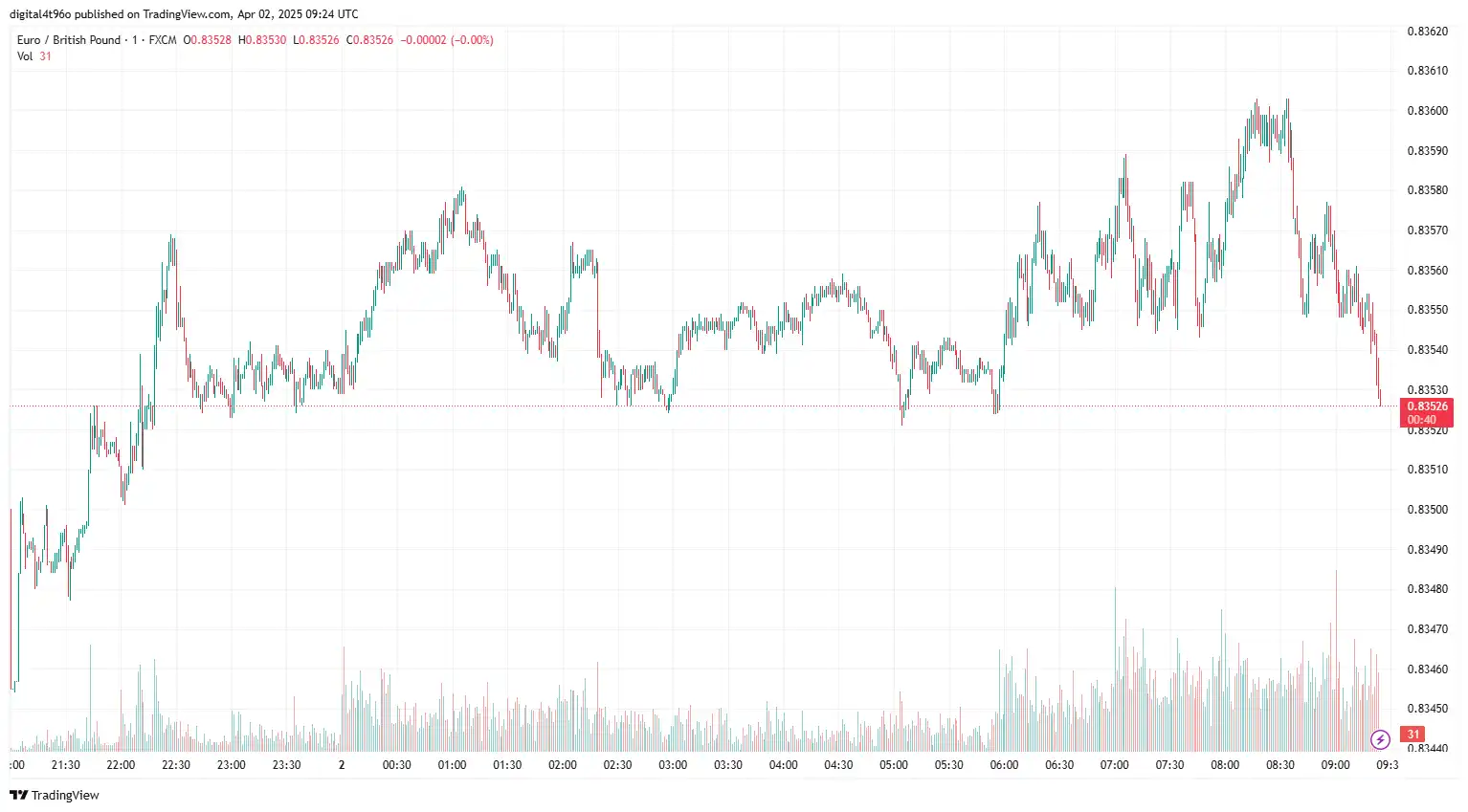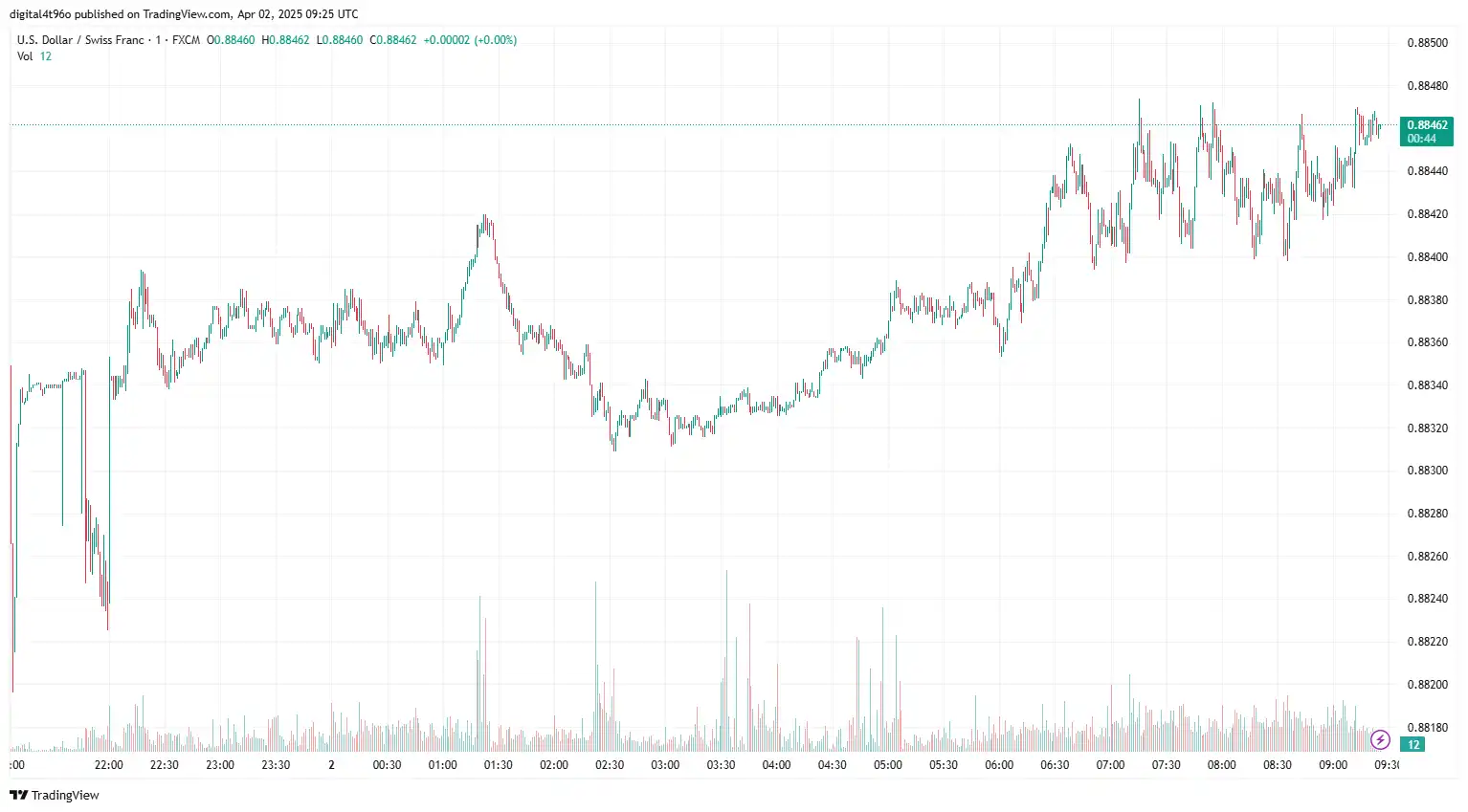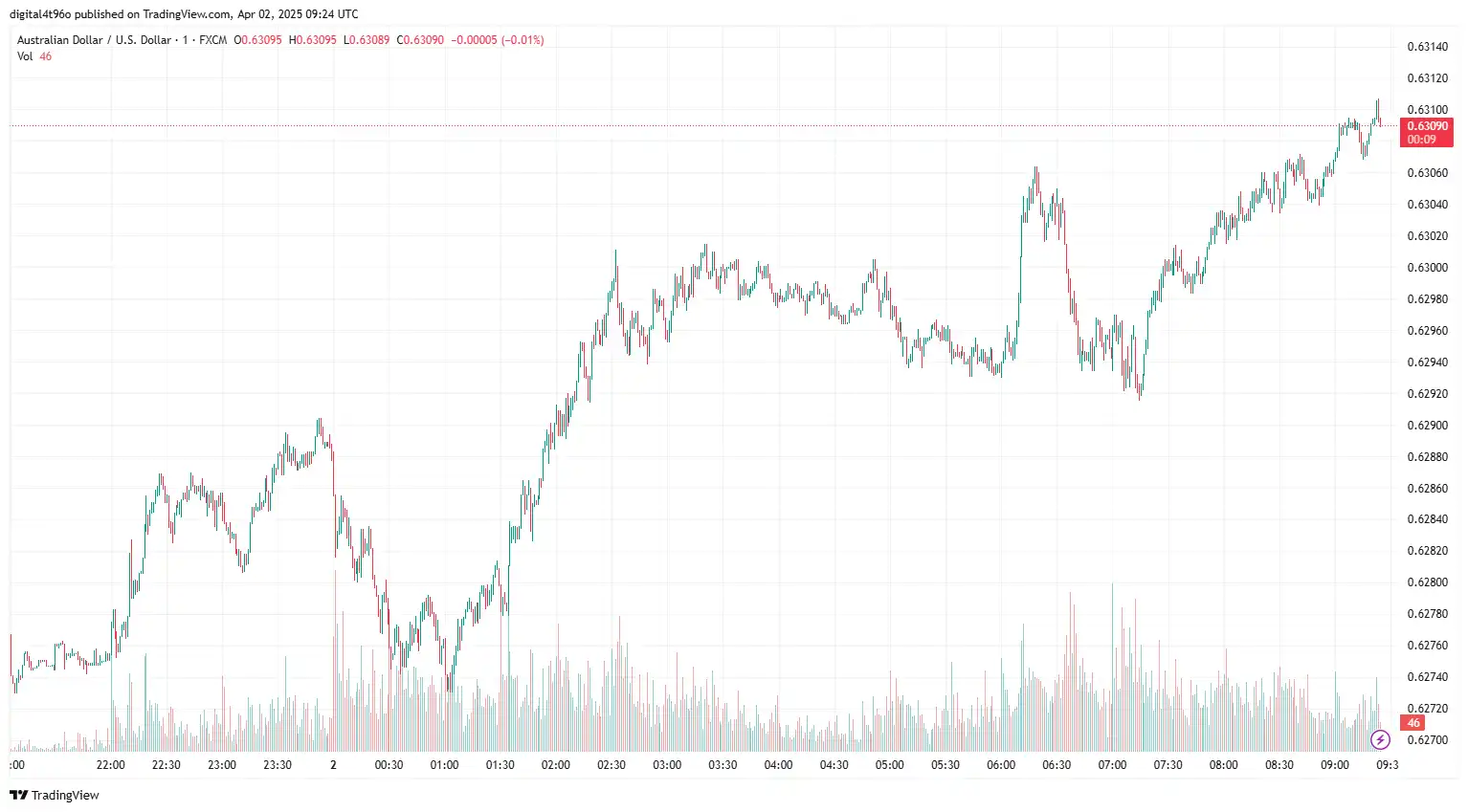GBP/USD Struggles After Softer JOLTS and ISM Reading
GBP/USD hovered near 1.2904, as the US dollar remained under pressure following weaker-than-expected economic data and cautious market sentiment ahead of President Trump's reciprocal tariffs announcement. Business activity in the US manufacturing sector contracted in March, with the ISM Manufacturing PMI falling to 49 from 50.3 in February, missing the market forecast of 49.5. The Employment Index dropped to 44.7 from 47.6, signalling a faster decline in manufacturing payrolls. In contrast, the Prices Paid Index — the survey's inflation component — rose to 69.4 from 62.4, indicating increased input costs.
Meanwhile, the number of job openings stood at 7.56 million on the last business day of February, according to the BLS Job Openings and Labor Turnover Survey (JOLTS). This was down from January's revised figure of 7.76 million and fell short of the expected 7.63 million. However, the downside in the greenback appears limited, as a slowdown in US economic activity, driven by tariffs, is expected to prompt the Federal Reserve (Fed) to restart its rate-cutting cycle soon. Globally, the increasing threat of a trade war—following President Trump's indication that tariffs would not be limited to countries with the largest trade imbalances—continues to dampen market sentiment. The upcoming Nonfarm Payrolls report for March is expected to show an increase of 105,000 jobs, following February's disappointing addition of 77,000. This projection will impact market expectations, especially as concerns grow over a potential slowdown in economic momentum.
On the other hand, sterling gains ground on expectations that the Bank of England (BoE) will pursue a more gradual policy easing cycle compared to other central banks. On Tuesday, BoE policymaker Megan Greene warned that "rising inflation expectations are a concern." Regarding inflation, Greene suggested that the net effect of US tariffs could be disinflationary for the UK, even though the direct impact on prices remains uncertain. She explained that countries previously exporting large volumes to the US may redirect their goods to markets like the UK at discounted prices — a process that could happen "fairly quickly."
In today's session, investors will be highly focused on President Trump's reciprocal tariff announcements. However, US ADP Nonfarm Employment Change data could also capture market attention and influence the GBP/USD exchange rate.

EUR/GBP Subdued by Eurozone Inflation Figures
EUR/GBP declined to 0.8357, as cooler-than-forecast Eurozone inflation figures fuelled speculation about the European Central Bank's (ECB) monetary policy stance. Germany's annual inflation rate, measured by the Consumer Price Index (CPI), eased slightly to 2.2% in March from 2.3% in February, according to preliminary data from Destatis released on Monday. On a monthly basis, the CPI rose by 0.3%, in line with market expectations. The Harmonised Index of Consumer Prices (HICP), the ECB's preferred inflation gauge, increased by 2.3% year-on-year in March, down from 2.6% in February and below analysts' forecasts of 2.4%, strengthening the case for further monetary easing.
In the Eurozone, manufacturing activity showed early signs of stabilisation in March, though results were mixed across member states. Spain's manufacturing PMI edged down to 49.5 from 49.7, marking a second consecutive month of contraction. Italy recorded a sharper decline, with its PMI falling to 46.6 from 47.4 — the largest drop in output in four months. In contrast, France's manufacturing sector showed modest improvement, as the PMI rose to 48.5 from 45.8, indicating a slower pace of contraction. Germany also saw progress, with its final manufacturing PMI increasing to 48.3 from 46.5, although still below the neutral 50 mark. At the regional level, the HCOB Eurozone Manufacturing PMI climbed to 48.6 in March from 47.6 in February — the highest reading in over two years — pointing to a milder decline in the bloc's manufacturing sector. Meanwhile, Italy's labour market continued to improve, with the unemployment rate falling to 5.9% in February from 6.3% in January—the lowest since April 2007. According to official figures, this decline was driven by a net gain of 47,000 jobs during the month.
However, President Trump's decision to impose the reciprocal tariff, effective April 2, along with the already announced duties, could create market anxiety among European traders, who are analysing its potential effects on the Eurozone economy. On the other hand, traders also continue to evaluate the potential economic risks posed by Trump's tariffs on the UK economy, creating cautious market sentiment around the GBP. The UK Office for Budget Responsibility (OBR) cautions that Trump's policies might erode the government's fiscal buffer and shrink the economy by up to 1%. This situation could compel the BoE to implement monetary easing to foster economic growth quickly. Traders anticipate that the BoE will lower interest rates twice this year, following one rate cut already executed in 2025.
In today's session, the market's reaction to President Trump's reciprocal tariff announcement and its impact on global economic growth will drive the EUR/GBP exchange rate.

USD/CHF Gains Amid Looming Trump Tariff
USD/CHF edges higher at 0.8843 as traders brace for details of US President Donald Trump's tariff plans. Trump announced plans to implement reciprocal tariffs on Wednesday, indicating that numerous nations with tariffs on US products may soon encounter new trade obstacles. Concerns about the US economy heightened this week after disappointing data emerged from the manufacturing sector. The ISM Manufacturing Purchasing Managers Index (PMI) dipped to 49 in March from 50.3 in February, falling short of the market expectation of 49.5 and indicating the first contraction in business activity in three months. Additionally, the report highlighted a notable increase in factory-gate inflation, with the Prices Paid Index rising to 69.4 from 62.4—its highest level in nearly three years—indicating increasing pressures from rising input costs. Meanwhile, the Employment Index declined to 44.7 from 47.6, which suggests a more pronounced decrease in manufacturing payrolls. Labour market data released separately contributed to the cautious outlook. The latest Job Openings and Labor Turnover Survey (JOLTS) revealed that job openings dropped to 7.56 million in February, down from a revised 7.76 million in January, falling below expectations of 7.63 million. Despite these indications of economic slowdown, the downward pressure on the US dollar remains limited. However, analysts propose that a broader deceleration—partly driven by renewed trade tensions and potential tariff expansions—could prompt the Federal Reserve to resume its rate-cutting strategy in the coming months. To further heighten market expectations, the March Nonfarm Payrolls report is expected later this week, with analysts predicting that the US economy added 105,000 jobs, following February's unexpectedly low figure of 77,000.
On the Swiss front, escalating global trade risks, heightened geopolitical tensions, and increased uncertainty could boost safe-haven demand, lending support to the Swiss Franc (CHF). Over the weekend, US President Donald Trump issued a warning to Iran, threatening military action and secondary tariffs should Tehran fail to reach an agreement with Washington on its nuclear programme. Meanwhile, Switzerland's manufacturing sector remained under pressure in March 2025. The latest procure.ch Manufacturing Purchasing Managers' Index (PMI) dropped to 48.9 from 49.6 in February, falling short of market expectations of 50.5. This marked the 27th consecutive month the index stayed below the neutral 50 level, signalling a persistent contraction in the sector. Retail sales in Switzerland rose by 1.6% year-on-year in February, easing from an upwardly revised 2.9% growth in January but still slightly above the forecast of 1.5%. This represents the slowest pace of growth since November 2024. The moderation was primarily driven by weaker demand for food, beverages, and tobacco, which grew by just 0.5% compared to 1.1% in the previous month. Non-food sales also lost momentum, increasing by 2% after a 4.9% rise in January. In contrast, sales at service stations saw a notable recovery, climbing by 3.9%, following a 3.2% decline previously. Monthly retail sales declined by 0.7% in February, reversing the 0.7% increase recorded in January. The slowdown in consumer spending and continued manufacturing weakness highlight broader challenges for the Swiss economy amid global uncertainty.
Broader market sentiment around geopolitical risks and the flow of safe-haven demand will significantly influence USD/CHF movements.

AUD/USD Buoyed Amid Risk-On Trade
AUD/USD gained ground near 0.6306, as optimistic market sentiment boosted the risk-sensitive Aussie. The Reserve Bank of Australia (RBA) chose to keep the Official Cash Rate (OCR) unchanged at 4.1% during its April monetary policy meeting, which was broadly anticipated. In the policy statement released, the central bank reaffirmed its cautious approach, stressing that achieving a sustainable return to the inflation target is its primary focus. It recognised the recent drop in underlying inflation as a positive sign while noting that the current monetary policy is still restrictive—suggesting the possibility of a rate reduction in May. In the post-meeting press conference, RBA Governor Michele Bullock clarified the Board's stance, stating, "We have to be careful not to get ahead of ourselves on policy." He added that a rate cut was not discussed during this meeting and that no decision about May has been made, further emphasising that "the Board did not open the door to a May rate cut." Regarding inflation, Bullock remarked, "We're gradually getting more confident, but we're not 100% there yet. It seems prudent to wait for a bit more data."
Australia's retail sales increased by 0.2% in February, following a 0.3% rise in January and missing the market's 0.3% expectation. This modest growth indicates slow consumer spending and aligns with the RBA's cautious outlook. RBA Assistant Governor Christopher Kent announced minor changes to repurchase agreement (repo) operations late Tuesday, emphasising that the adjustments do not reflect any shift in monetary policy. Effective April 9, the RBA will raise the pricing on new open market operation (OMO) repos by five basis points, bringing them to 10 basis points above the cash rate target. A new seven-day term will also be introduced alongside the existing 28-day term.
On the global front, US President Donald Trump is expected to announce new tariffs on US trading partners on Wednesday, potentially expanding duties on Chinese goods. Trump has already imposed 20% tariffs on all Chinese imports, citing Beijing's failure to curb the export of chemicals linked to fentanyl production. Rising trade tensions between the US and China may weigh on the Australian dollar. However, upbeat Chinese manufacturing data may support the currency. The Caixin Manufacturing PMI rose to 51.2 in March from 50.8 in February, exceeding expectations of 51.1. The NBS Manufacturing PMI also increased to 50.5 from 50.2, meeting forecasts. The NBS Non-Manufacturing PMI rose to 50.8 from 50.4, surpassing expectations of 50.5. However, uncertainty surrounding Trump's proposed tariffs may introduce volatility, potentially offsetting the boost from stronger Chinese data.
On the other hand, softer US ISM manufacturing data for March, coupled with growing uncertainty around tariff-related trade risks, continues to pressure the greenback. The US ISM Manufacturing PMI for March fell deeper into contraction at 49.0, missing expectations of 49.5 and down from 50.3. The Prices Paid Index rose to 69.4, surpassing forecasts of 65 and up from 62.4. New Orders dropped to 45.2 from 48.6, and the Employment Index declined to 44.7 from 47.6. The US JOLTS Job Openings for February were also weaker, falling to 7.568 million—below the forecast of 7.63 million and down from 7.74 million in January.
In upcoming sessions, persistent concerns over the economic fallout from the US tariff policy and the risk of a deeper US-China trade war could weigh on the Aussie, influencing AUD/USD movements.

Stay Ahead in the Currency Game
Whether you're a daily FX trader or handle international transactions regularly, our 'Currency Pulse' newsletter delivers the news you need to make more informed decisions. Receive concise updates and in-depth insights directly in your LinkedIn feed.
Subscribe to 'Currency Pulse' now and never miss a beat in the currency markets!
Ready to act on today’s insights? Get a free quote or give us a call on: +44 (0)20 7740 0000 to connect with a dedicated portfolio manager for tailored support.
Important: This blog is for informational purposes only and should not be considered financial advice. Currency Solutions does not consider individual investment goals, financial circumstances, or specific requirements of readers. We do not endorse or recommend any particular financial strategies or products discussed. Currency Solutions provides this content as is, without any guarantees of completeness, accuracy, or timeliness.




